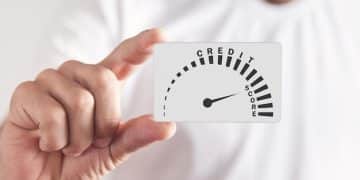Maximize Your Personal Finance: 3 Strategies to Reduce Debt by 15% in 6 Months

Achieving a 15% debt reduction within six months is attainable by implementing a focused financial strategy that includes meticulous budget analysis, targeted debt payments, and strategic income generation, offering a proven pathway to enhanced financial health and stability.
Embarking on a journey to financial freedom often feels daunting, yet taking decisive steps can yield significant results. This article explores how to maximize your personal finance: 3 strategies to reduce debt by 15% in the next 6 months, transforming what might seem like an uphill battle into a clear, achievable goal. By applying smart money management principles and a disciplined approach, you can strategically chip away at your debt, paving the way for a more secure financial future.
Understanding Your Debt Landscape: The Foundation of Reduction
Before any significant debt reduction can occur, a comprehensive understanding of your current financial obligations is paramount. This initial phase isn’t merely about listing what you owe, but rather deeply analyzing the nature of your debts: their types, interest rates, minimum payments, and overall impact on your budget. Without this foundational clarity, any strategy implemented risks being inefficient or, worse, unsustainable.
Categorizing Your Debts
Debts are not monolithic; they come in various forms, each with its own set of characteristics that influence how effectively they can be managed and repaid. Identifying and categorizing these distinct types of debt is the first critical step in developing a cohesive reduction strategy. This classification helps in prioritizing which debts to tackle first, based on factors such as interest rates and payment terms.
- High-Interest Debts: Credit card balances, personal loans, or certain retail store cards often carry exorbitant interest rates. These debts accrue rapidly, making them priority targets for accelerated repayment.
- Secured Debts: Mortgages and auto loans are examples of secured debts, backed by an asset. While usually having lower interest rates, they represent significant long-term commitments that demand consistent attention.
- Unsecured Debts: Student loans and medical bills fall into this category. Though not typically tied to an asset, they can still profoundly impact your financial health, especially if left unaddressed.
Each category presents unique challenges and opportunities for reduction. For instance, high-interest debts inflict the most damage over time, acting like a corrosive agent on your finances. Conversely, secured debts, while substantial, often offer structured payment plans that can sometimes be renegotiated or refinanced under more favorable terms.
Assessing Interest Rates and Terms
Interest rates are the silent killers of financial progress. A debt with a high interest rate means a larger portion of your monthly payment goes towards interest rather than the principal, prolonging your repayment period and increasing the total cost of the debt. It’s crucial to know the exact interest rate for each of your debts, as this will heavily influence which strategy—such as the avalanche method—you choose to employ.
Beyond the interest rate, understanding the terms of your debt is equally vital. Are there prepayment penalties? Are there options for deferred payments or hardship programs? Knowing these details can open doors to surprising flexibility or, conversely, highlight areas where caution is needed. This detailed analysis allows you to pinpoint the debts that are costing you the most and allocate resources accordingly.
By meticulously categorizing debts and scrutinizing their interest rates and terms, you lay a solid groundwork for strategic financial planning. This comprehensive understanding ensures that your debt reduction efforts are not scattershot but rather focused, efficient, and tailored to your specific financial landscape, bringing you closer to your 15% reduction goal.
Strategy 1: Building a Dynamic Budget and Unleashing Savings
The cornerstone of any effective debt reduction plan is a robust and dynamic budget. This isn’t just about tracking where your money goes; it’s about actively managing it to free up capital for debt repayment. By creating a clear picture of your income and expenditures, you can identify areas for significant savings, turning potential waste into powerful tools for debt elimination.
Crafting Your Budget: Income vs. Expenses
A well-structured budget begins with an honest assessment of your income versus your expenses. List all sources of income and then meticulously track every outgoing dollar. This involves everything from fixed costs like rent and loan payments to variable expenses such as groceries, entertainment, and transportation. Many people underestimate how much they spend on discretionary items, which often represent the easiest targets for cuts.
Use budgeting apps, spreadsheets, or even a simple notebook to record every transaction for at least a month. This period of meticulous tracking reveals spending patterns you might not be aware of, offering invaluable insights into where your money truly goes. The goal is to identify discrepancies between your perceived spending and your actual spending, providing a clear roadmap for where adjustments are possible.
Identifying and Slashing Unnecessary Expenditures
Once you have a clear picture of your spending, the next step is to identify and aggressively cut unnecessary expenditures. These ‘financial leaks’ often include subscriptions you don’t use, impulse purchases, excessive dining out, or unused gym memberships. Even small, recurring expenses can add up significantly over time, diverting funds that could otherwise be used to pay down debt.
- Subscription Services Audit: Review all your monthly subscriptions. Are you truly using and benefiting from every streaming service, app, or membership? Cancel those that provide little value.
- Dining Out Reduction: Eating at home is almost always cheaper than dining out. Plan meals, cook in bulk, and bring lunches to work. Even reducing dining out by half can result in substantial savings.
- Impulse Purchase Control: Implement a ’24-hour rule’ for non-essential purchases. If you still want the item after 24 hours, consider if it fits your budget. This delay often prevents unnecessary spending.
This phase requires discipline and a willingness to make temporary sacrifices. The key is to distinguish between needs and wants. While some wants contribute to quality of life, during a debt reduction phase, many can be temporarily deferred or eliminated. Every dollar saved from these cuts is a dollar that can be put directly towards reducing your debt principal, accelerating your progress towards the 15% goal.
The collective impact of these small changes can be profound. By creating a dynamic budget that actively seeks out and eliminates unnecessary expenditures, you create a powerful stream of funds dedicated solely to debt reduction. This strategic allocation of resources not only helps you reach your financial goals faster but also instills valuable habits for long-term financial health.

Strategy 2: The Power of Targeted Debt Repayment Methods
Once you have freed up capital through budgeting and savings, the next crucial step is to apply it strategically to your debts. This involves choosing a targeted repayment method that aligns with your financial temperament and offers the most efficient path to reducing your debt by 15% within six months. Two prominent methods stand out: the debt snowball and the debt avalanche.
The Debt Snowball Method: Building Momentum
The debt snowball method focuses on psychological wins to maintain motivation. With this approach, you list all your debts from the smallest balance to the largest, regardless of interest rate. You then make minimum payments on all debts except the smallest one, on which you focus all your extra funds. Once the smallest debt is paid off, you take the money you were paying on it and add it to the payment for the next smallest debt. This creates a “snowball” effect, where your payments grow larger as each debt is eliminated.
While mathematically less efficient than the avalanche method (because it doesn’t prioritize high-interest debts), the snowball method provides quick wins that can be incredibly motivating. Seeing debts disappear one by one can give you the momentum needed to stick with your plan, especially in the early stages when progress might otherwise feel slow. For those who need constant reinforcement and visual proof of progress, the debt snowball can be a powerful tool for consistency and commitment.
The Debt Avalanche Method: Maximizing Savings
The debt avalanche method is the mathematically most efficient way to pay off debt. With this approach, you list all your debts from the highest interest rate to the lowest, regardless of the balance. You then make minimum payments on all debts except the one with the highest interest rate, on which you focus all your extra funds. Once the highest-interest debt is paid off, you move on to the next highest interest rate, rolling over the payment from the previous debt.
This method saves you the most money on interest over time. By tackling the debts that cost you the most daily, you minimize the total amount you repay. While it might take longer to see the first debt completely eliminated, the financial benefits are substantial. For those who prioritize saving money and are driven by financial optimization, the debt avalanche is the preferred choice, ensuring that every extra dollar goes the furthest in reducing your total debt burden.
Choosing the Right Method for You
The choice between the debt snowball and debt avalanche methods depends largely on your personal financial psychology. If you need immediate motivation and quick wins to stay on track, the snowball method might be more effective. If you are disciplined and want to save the most money on interest, the avalanche method is the better choice. Some individuals even combine aspects of both, perhaps starting with a small snowball to build initial momentum and then transitioning to an avalanche once their discipline is stronger.
Regardless of the method chosen, consistency is key. By diligently applying extra payments to your targeted debt, you accelerate its demise, bringing you closer to your 15% reduction goal within the six-month timeframe. This intentional and strategic application of funds is what transforms a simple budget into a powerful debt-destroying machine.
Strategy 3: Boosting Your Income for Accelerated Debt Payoff
While cutting expenses is crucial, sometimes it’s simply not enough to reach ambitious debt reduction goals. This is where the third strategy comes into play: actively increasing your income. By generating additional revenue, you create a powerful acceleration for your debt repayment efforts, allowing you to hit your 15% reduction target significantly faster. This isn’t about mere minimum payments; it’s about making substantial inroads into your principal.
Exploring Side Hustles and Freelancing
The advent of the gig economy has opened up myriad opportunities for individuals to earn extra income outside their primary jobs. These “side hustles” can range from driving for ride-sharing services, delivering food, or walking dogs, to leveraging professional skills through freelancing platforms. If you have a specific skill—whether it’s writing, graphic design, web development, virtual assistance, or tutoring—there’s likely a market for it.
- Leverage Existing Skills: Consider what you’re already good at. Can you offer consulting, create digital content, or teach a language? Platforms like Upwork, Fiverr, or remote job boards can connect you with clients.
- Utilize Assets: Do you have spare rooms, a car, or even a well-maintained lawnmower? Consider renting out space, driving for ride-shares, or offering landscaping services.
- Seasonal Opportunities: Explore demand-driven opportunities during peak seasons, such as holiday retail work, tax preparation, or event staffing.
The key here is finding a side hustle that either brings you genuine enjoyment or is so simple to execute that it doesn’t cause burnout. The extra income generated should be channeled directly into your debt repayment, supplementing the funds saved from your budgeting efforts. This dual approach of saving more and earning more significantly amplifies your capacity to reduce debt.
Maximizing Your Current Employment
Beyond external opportunities, look for ways to increase your income within your existing employment. This could involve asking for a raise, taking on additional responsibilities that warrant extra compensation, or even exploring opportunities for overtime. Many employers value proactive employees who demonstrate a willingness to contribute more, and this value can often translate into increased earnings.
Consider negotiating your salary during your annual review, taking into account your performance and market rates for your position. If a raise isn’t immediately feasible, inquire about taking on special projects that could lead to bonuses or a promotion. Even minor increases in your regular paycheck, when consistently applied to debt, can have a noticeable impact over six months.
Another option, though more drastic, is to explore a new job that offers a higher salary. While this might involve a more significant career change, the long-term benefits for your financial health could be immense. However, this decision should be weighed carefully against the stability and benefits of your current role.
By strategically boosting your income, whether through side hustles or leveraging your primary employment, you turn your earning potential into a formidable weapon against debt. This extra capital, when combined with disciplined budgeting and targeted repayment methods, creates a powerful synergy that can significantly accelerate your journey toward achieving a 15% debt reduction and beyond.
Optimizing Grocery Savings: A Direct Path to Debt Reduction

While the previous strategies focus on broad financial maneuvers, optimizing your grocery spending offers a direct and often overlooked avenue for significant savings. For many households, groceries represent one of the largest variable expenses, making them a prime target for cuts that can directly free up funds for debt reduction. Even small, consistent savings here translate into substantial contributions over six months.
Meal Planning and Smart Shopping
The most effective way to reduce grocery bills begins with meticulous meal planning. Before stepping into a store, decide on every meal for the week, including snacks. Create a shopping list based solely on these planned meals, and stick to it rigorously. Avoid impulse purchases, which are a notorious budget buster. Shopping only for what you need minimizes waste and prevents buying unnecessary items that often go bad.
Beyond planning, smart shopping habits are key. This includes buying generic brands over name-brand products, which often offer comparable quality at a fraction of the cost. Utilize unit pricing (price per ounce or pound) to determine the best value, especially for staples like rice, pasta, or canned goods. Buying in bulk can also be cost-effective for non-perishables, but only if you have the storage space and will genuinely use the quantity before it expires.
Leveraging Sales, Coupons, and Loyalty Programs
Never pay full price for groceries if you don’t have to. Become a savvy consumer by actively seeking out sales and promotions. Check weekly store circulars, download store apps for digital coupons, and sign up for loyalty programs. These programs often provide exclusive discounts, personalized offers, and rewards points that can further reduce your bill.
Timing your shopping trips to coincide with sales cycles can lead to significant savings. Stock up on non-perishable items when they are at their lowest price. However, be cautious not to buy items just because they are on sale if you don’t actually need them or won’t use them, as this negates the savings. The goal is strategic purchasing, not hoarding.
Cooking at Home and Reducing Food Waste
Cooking at home is almost universally cheaper and healthier than eating out. Embrace home-cooked meals as a regular part of your debt reduction strategy. Batch cooking, where you prepare larger quantities of food once or twice a week, can save time and money by providing leftovers for lunches or future dinners, minimizing the temptation to buy expensive convenience food.
Equally important is reducing food waste. Americans discard a significant amount of food annually, which is essentially money thrown away. Learn to properly store food to extend its shelf life, repurpose leftovers creatively, and understand expiration dates (many items are still safe to consume after their “best by” date). Composting food scraps can also be considered, though its direct financial impact is less significant than preventing edible food waste.
By implementing these grocery saving strategies, you directly convert potential spending into additional funds for debt repayment. The consistent application of these habits—from thoughtful meal planning to waste reduction—creates a reliable stream of savings that, when combined with your other debt reduction efforts, significantly propels you towards your 15% goal within the targeted six-month period.
Monitoring Progress and Staying Motivated
Achieving a 15% debt reduction in six months requires not just a solid plan but also consistent monitoring and continuous motivation. It’s easy to get sidetracked or discouraged, so establishing systems to track your progress and celebrate milestones is crucial for sustaining momentum and ensuring you stay on course.
Tracking Your Debt Reduction Journey
Regularly reviewing your financial standing is non-negotiable. Whether you use a spreadsheet, a budgeting app, or simply a ledger, make it a habit to check your debt balances at least once a month. This allows you to see the tangible results of your efforts, ensuring you are indeed chipping away at that 15% target. Visualizing your declining debt numbers can be incredibly motivating.
Beyond just balances, track your progress against your established budget. Are you sticking to your spending limits? Are you consistently dedicating the freed-up funds to debt? Identifying deviations early allows for quick corrections before they derail your overall plan. This proactive approach turns potential setbacks into minor adjustments, keeping you aligned with your six-month goal.
Setting Milestones and Celebrating Small Wins
The journey to financial freedom is a marathon, not a sprint. Breaking down your 15% reduction goal into smaller, manageable milestones can make the process feel less overwhelming. For instance, instead of focusing solely on the end goal, celebrate when you pay off your first small debt (if using the snowball method), or when you’ve reduced your overall principal by 2%, then 5%, then 10%.
- Visual Trackers: Use charts, graphs, or even a physical thermometer to visually represent your debt reduction progress. Seeing the “line” move can be very encouraging.
- Non-Monetary Rewards: When you hit a milestone, reward yourself with something that doesn’t set you back financially. This could be a relaxing evening with a movie, a hike, or a small, guilt-free treat like a coffee. Avoiding monetary rewards reinforces your financial discipline.
- Share Your Journey: If comfortable, share your progress with a trusted friend or family member who can offer encouragement and accountability. Having a support system can provide invaluable external motivation.
These small celebrations provide crucial psychological boosts, reinforcing positive financial behaviors and preventing burnout. They turn what could be a grueling six-month period into a series of achievable quests, each bringing you closer to your ultimate financial objective.
Adjusting Your Strategy as Needed
Life is unpredictable, and your financial situation might change over six months. Be prepared to revisit and adjust your strategy as circumstances evolve. If an unexpected expense arises, or if your income changes, reassess your budget and your debt repayment plan. Flexibility is key to long-term success; rigidity can lead to frustration and abandonment of goals.
Regular monitoring helps you identify what’s working and what isn’t. Maybe a particular expense cut was too aggressive, or a side hustle isn’t yielding the expected income. Don’t be afraid to tweak your approach based on real-world results. The goal is consistent, incremental progress rather than perfect adherence to an unworkable plan. By remaining adaptable and diligent, you ensure your debt reduction journey remains on track, leading you successfully to a 15% reduction and a stronger financial footing.
Beyond Debt Reduction: Building Long-Term Financial Resilience
Achieving a 15% debt reduction in six months is not merely an end in itself; it’s a powerful springboard towards building lasting financial resilience. The habits and discipline cultivated during this intense period are invaluable assets that can secure your financial future for years to come. This phase isn’t about maintaining the same frantic pace, but integrating the lessons learned into a sustainable, proactive financial lifestyle.
Establishing an Emergency Fund
One of the most critical steps after making significant inroads into debt is to establish a robust emergency fund. This fund acts as a financial safety net, designed to cover unexpected expenses like job loss, medical emergencies, or significant home repairs without forcing you back into debt. Experts typically recommend having 3 to 6 months’ worth of living expenses saved in an easily accessible, high-yield savings account.
The discipline you developed during debt reduction—the focused saving and strategic allocation of funds—can be directly applied to building this fund. Think of it as preventative debt management; by having an emergency fund, you insulate yourself from unforeseen circumstances that would otherwise necessitate borrowing, thereby preventing a relapse into financial instability.
Investing for Your Future
Once your debt is significantly reduced (beyond the 15% mark) and an emergency fund is in place, the next logical step is to turn your attention to investing. This is where your money starts working for you, building wealth over the long term. Investing can take many forms, from contributing to retirement accounts like 401(k)s or IRAs, to exploring diversified investment portfolios in mutual funds or exchange-traded funds (ETFs).
The power of compound interest, which worked against you with high-interest debt, now becomes your greatest ally. By starting early and contributing consistently, even modest investments can grow substantially over decades. Education is paramount here; understanding different investment vehicles, risk tolerance, and long-term financial goals will guide your choices and ensure your investments align with your future aspirations.
Continuous Financial Education and Adaptation
The financial landscape is ever-evolving, and staying informed is crucial for long-term resilience. Continue to educate yourself about personal finance, economic trends, and new investment opportunities. This commitment to lifelong learning will empower you to make informed decisions and adapt your strategies as your life circumstances change, such as career advancements, starting a family, or preparing for retirement.
Regularly review your budget, investment portfolio, and overall financial plan. Life changes, and so should your financial strategy. This proactive approach ensures that the financial stability you’ve earned through debt reduction isn’t merely a temporary achievement but a continuously reinforced foundation for a prosperous and secure future. The skills honed during your six-month debt reduction journey are not just for paying off debt; they are for an entire lifetime of financial mastery.
| Key Point | Brief Description |
|---|---|
| 📊 Budget Mastery | Identify and cut unnecessary expenditures to free up funds for debt repayment. |
| ⚡ Targeted Payoff | Apply debt snowball or avalanche methods for efficient and motivated debt reduction. |
| 💰 Income Boost | Supplement income with side hustles or job optimization to accelerate payments. |
| 🛒 Smart Grocery Savings | Reduce food waste and utilize meal planning, coupons, and sales to save on groceries. |
Frequently asked questions by our readers
▼
Yes, achieving a 15% debt reduction in six months is a realistic and attainable goal for many, especially when implementing a combination of the strategies outlined. It requires consistent effort, disciplined budgeting, and a proactive approach to managing finances. The specific feasibility depends on your current income, total debt, and spending habits, but with strategic planning and commitment, significant progress is definitely possible.
▼
The debt snowball method prioritizes paying off your smallest debts first to gain psychological momentum, regardless of interest rates. In contrast, the debt avalanche method focuses on paying off debts with the highest interest rates first, saving you the most money on interest over time. The choice between them often depends on whether you prioritize motivation through quick wins or maximizing financial savings.
▼
Grocery savings directly impact debt reduction by freeing up a significant portion of your variable expenses. By implementing meal planning, smart shopping (using coupons, sales, and loyalty programs), and reducing food waste, you can convert money typically spent on groceries into funds that can be directly applied to your debt payments. Even small, consistent savings here accumulate rapidly over six months.
▼
Ideally, you should focus on both simultaneously. Decreasing expenses gives you immediate control over your outflow, often providing quicker initial funds for debt repayment. Increasing income, through side hustles or job optimization, accelerates this process significantly. The combination creates a powerful synergy, making your debt reduction efforts much more effective and increasing your chances of hitting your 15% target faster.
▼
Once you’ve achieved your 15% debt reduction goal, it’s crucial to leverage the momentum and discipline you’ve built. The next steps typically involve establishing a robust emergency fund to guard against future financial shocks, and then transitioning into long-term wealth building through investing. Continuing to refine your budgeting skills and maintaining financial literacy will ensure lasting financial resilience and growth.
Conclusion
Achieving a 15% debt reduction within six months is an ambitious yet entirely attainable objective, serving as a pivotal step towards financial independence. By diligently applying strategies such as building a dynamic budget, utilizing targeted debt repayment methods, and actively boosting your income, you are not just chipping away at debt but fundamentally reshaping your financial trajectory. The discipline and habits cultivated during this intensive period—including smart grocery savings—will serve as a bedrock for future financial resilience, enabling you to move beyond debt and towards a secure, prosperous future where your money works for you, rather than against you.





